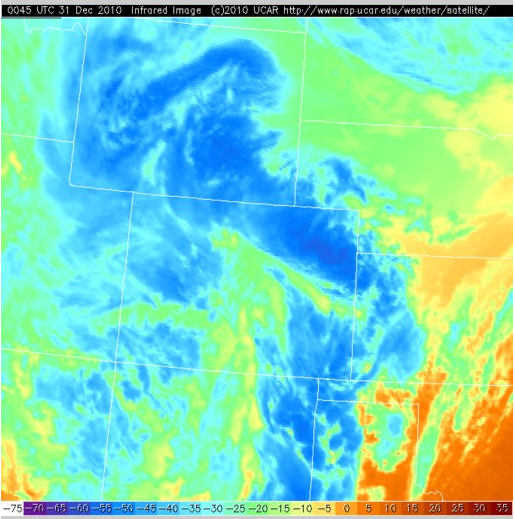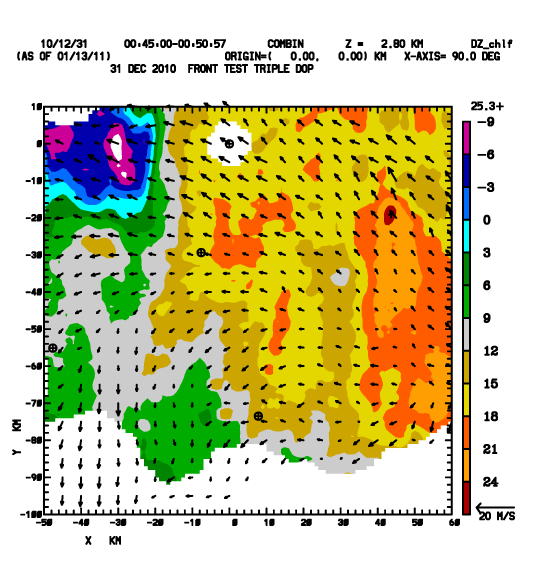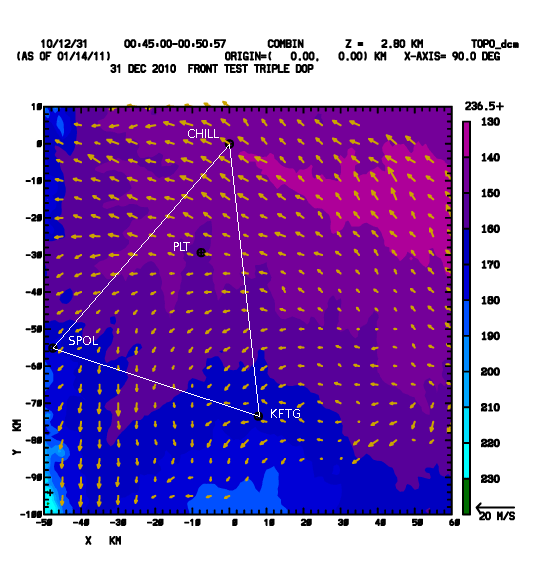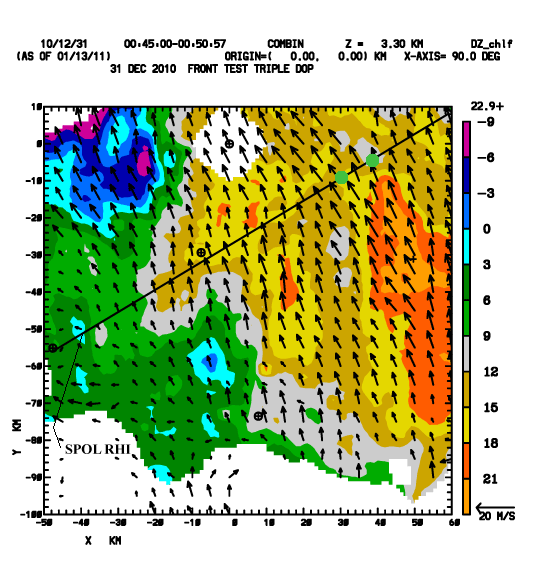Example Multiple-Doppler Radar Analysis from the Colorado Front Range area: 31 Dec 2010: Difference between revisions
Pat kennedy (talk | contribs) (initial posting) |
Pat kennedy (talk | contribs) No edit summary |
||
| Line 52: | Line 52: | ||
The final plot was made from the SPOL RHI scan data. The color | The final plot was made from the SPOL RHI scan data. The color | ||
fill is reflectivity; contours showing the 0.1 and 0.15 deg / km | fill is reflectivity; contours showing the 0.1 and 0.15 deg / km | ||
specific differential phase ( | one-way specific differential phase (<math>K_{dp}</math>) levels are shown as an overlay. | ||
(The green dots on the RHI line in the preceding plot show the | (The green dots on the RHI line in the preceding plot show the | ||
90 and 100 km range points that approximately bracket the positive | 90 and 100 km range points that approximately bracket the positive | ||
<math>K_{dp}</math> area.) This weak positive <math>K_{dp}</math> area is probably | |||
due to a relatively high concentration | due to a relatively high concentration | ||
of quasi-horizontally oriented planar ice crystals. The aggregation | of quasi-horizontally oriented planar ice crystals. The aggregation | ||
of these crystals into irregularly-shaped clumps at lower heights | of these crystals into irregularly-shaped clumps at lower heights | ||
causes | causes <math>K_{dp}</math> to decrease and reflectivity to increase towards the ground: | ||
[[Image:31dec2010 SPOL RHI Z Kdp c1.png]] | [[Image:31dec2010 SPOL RHI Z Kdp c1.png]] | ||
Revision as of 10:57, 21 January 2011
Introduction
During the winter of 2010 - 2011, NASA temporarily installed several pieces of remote sensing equipment at the NOAA field site near Platteville, Colorado to collect data for a study of aircraft icing. To support this effort, the CSU-CHILL and EOL S-POL radars collected polarimetric data on several occasions when icing conditions were expected. It is anticipated that this "target of opportunity" radar operation regime is one of the data collection modes that will be used when the NCAR-CSU Front Range Observational Network Testbed (FRONT) becomes operational. This web page presents some examples of the data that can be collected routinely via coordinated operations of the EOL S-POL and CSU-CHILL radars while they are located at their home-base sites.
IR Satellite Image at 0045 UTC
Widespread snow was forecast on 30 - 31 December 2010 due to the passage of well-defined, synoptic scale trough system. At 0045 UTC on the 31st, IR satellite imagery showed that the circulation associated with this trough was developing a dry slot configuration over north-central Colorado:
Multiple Doppler Wind Field Syntheses
The antenna controllers at CHILL and S-POL were automatically starting surveillance scan volumes at 7.5 minute intervals. 0045 UTC was one such synchronized starting time. The NWS KFTG radar started a volume scan at 0045:27 UTC. Due to the close agreement with the volume starting time of the research radars, a multiple-Doppler wind field synthesis could be done using the radial velocity data from all three radars. (These analyses were done using NCAR's SPRINT and CEDRIC software.) The resultant Earth-relative flow field at a height of 2.8 km MSL is shown below. The color fill is the CHILL reflectivity field; the strongest reflectivities are found near the eastern portion of the analysis grid in association with the colder IR cloud top area:
The next image again shows the 2.8 km MSL flow vectors, now plotted on terrain elevation contours. (The elevations are in decameters; 150 = 1.5 km MSL) In the southwestern portion of the grid, it appears that the higher terrain of the foothills may have deflected the flow of cold, dense low level air towards the south:
500m higher up at the 3.8 km MSL analysis level, winds had strengthened and generally shifted to a more southerly direction. This plot also shows the location of an RHI scan done by S-POL at 0052 UTC:
S-Pol RHI Scan Data
The final plot was made from the SPOL RHI scan data. The color fill is reflectivity; contours showing the 0.1 and 0.15 deg / km one-way specific differential phase () levels are shown as an overlay. (The green dots on the RHI line in the preceding plot show the 90 and 100 km range points that approximately bracket the positive area.) This weak positive area is probably due to a relatively high concentration of quasi-horizontally oriented planar ice crystals. The aggregation of these crystals into irregularly-shaped clumps at lower heights causes to decrease and reflectivity to increase towards the ground:
The data presented here are representative of the type of measurements that the FRONT radar network will readily be able to provide to the atmospheric research and education communities.
Acknowledgments: Jay Miller and John Tuttle provided the digital terrain elevation data set. Bob Rilling made the S-POL data files available on a short turn-around basis. (Jay, John, and Bob are all affiliated with NCAR).





